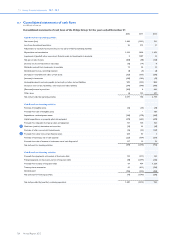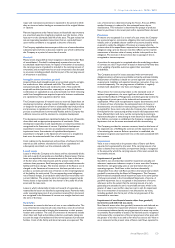Philips 2012 Annual Report Download - page 131
Download and view the complete annual report
Please find page 131 of the 2012 Philips annual report below. You can navigate through the pages in the report by either clicking on the pages listed below, or by using the keyword search tool below to find specific information within the annual report.
12 Group financial statements 12.10 - 12.10
Annual Report 2012 131
arising from a business combination only in the aforementioned period,
any subsequent changes in the measurement of contingent
consideration will continue to be treated as an adjustment to the
combination’s cost, and thus goodwill, until the amount of
consideration is finally determined.
Acquisitions of and adjustments to non-controlling interests
Acquisitions of non-controlling interests are accounted for as
transactions with owners in their capacity as owners and therefore no
goodwill is recognized as a result. Adjustments to non-controlling
interests arising from transactions that do not involve the loss of
control are based on a proportionate amount of the net assets of the
subsidiary.
For changes to non-controlling interest without the loss of control, the
difference between such change and any consideration paid or received
is recognized directly in equity.
Loss of control
Upon the loss of control, the Company derecognizes the assets and
liabilities of the subsidiary, any non-controlling interests and the other
components of equity related to the subsidiary. Any surplus or deficit
arising on the loss of control is recognized in profit or loss. If the
Company retains any interest in the previous subsidiary, then such
interest is measured at fair value at the date the control is lost.
Subsequently it is accounted for as an equity-accounted investee or as
an available-for-sale financial asset depending on the level of influence
retained.
Investments in associates (equity-accounted investees)
Associates are all entities over which the Company has significant
influence, but not control. Significant influence is presumed with a
shareholding of between 20% and 50% of the voting rights. Investments
in associates are accounted for using the equity method of accounting
and are initially recognized at cost. The group’s investment in associates
includes goodwill identified on acquisition, net of any accumulated
impairment loss.
The Company’s share of the net income of these companies is included
in results relating to associates in the Statement of income, after
adjustments to align the accounting policies with those of the Company,
from the date that significant influence commences until the date that
significant influence ceases. When the Company’s share of losses
exceeds its interest in an associate, the carrying amount of that interest
(including any long-term loans) is reduced to zero and recognition of
further losses is discontinued except to the extent that the Company
has incurred legal or constructive obligations or made payments on
behalf of an associate. Unrealized gains on transactions between the
Company and its associates are eliminated to the extent of the
Company’s interest in the associates. Unrealized losses are also
eliminated unless the transaction provides evidence of an impairment
of the asset transferred. Remeasurement differences of equity stake
resulting from gaining control over the investee previously recorded as
associate are recorded under results related to investments in
associates.
Investments in associates include loans from the Company to these
investees.
Accounting for capital transactions of a consolidated
subsidiary or an associate
The Company recognizes dilution gains or losses arising from the sale
or issuance of stock by a consolidated subsidiary or an associate in the
Statement of income, unless the Company or the subsidiary either has
reacquired or plans to reacquire such shares. In such instances, the
result of the transaction will be recorded directly in equity.
Dilution gains and losses arising in investments in associates are
recognized in the Consolidated statements of income under “Results
relating to investments in associates”.
Foreign currencies
Foreign currency transactions
The financial statements of all group entities are measured using the
currency of the primary economic environment in which the entity
operates (functional currency). The euro (EUR) is the functional and
presentation currency of the Company. Foreign currency transactions
are translated into the functional currency using the exchange rates
prevailing at the dates of the transactions or valuation where items are
remeasured. Foreign exchange gains and losses resulting from the
settlement of such transactions and from the translation at year-end
exchange rates of monetary assets and liabilities denominated in foreign
currencies are recognized in the Statement of income, except when
deferred in other comprehensive income as qualifying cash flow hedges
and qualifying net investment hedges.
Foreign currency differences arising on retranslation are recognized in
profit or loss, except for available-for-sale equity investments (except
on impairment in which case foreign currency differences that have
been recognized in other comprehensive income are reclassified to
profit and loss), which are recognized in other comprehensive income.
All exchange difference items are presented in the same line item as
they relate in the Statement of income. However, the results ensuing
from fluctuations in foreign currency exchange rates with respect to
accounts receivables, accounts payables and intercompany current
accounts are credited or debited to Cost of sales.
Non-monetary assets and liabilities denominated in foreign currencies
that are measured at fair value are retranslated to the functional
currency using the exchange rate at the date the fair value was
determined. Non-monetary items in a foreign currency that are
measured based on historical cost are translated using the exchange
rate at the date of transaction.
Foreign operations
The assets and liabilities of foreign operations, including goodwill and
fair value adjustments arising on acquisition, are translated to euro at
exchange rates at the reporting date. The income and expenses of
foreign operations, are translated to euro at exchange rates at the dates
of the transactions.
Foreign currency differences arising on translation of foreign operations
into the group’s presentation currency are recognized in other
comprehensive income, and presented in the foreign currency
translation reserve (translation reserve) in equity. However, if the
operation is a non-wholly owned subsidiary, then the relevant
proportionate share of the translation difference is allocated to the
non-controlling interests. When a foreign operation is disposed of such
that control, significant influence or joint control is lost, the cumulative
amount in the translation reserve related to the foreign operation is
reclassified to the Statement of income as part of the gain or loss on
disposal. When the Company disposes of only part of its interest in a
subsidiary that includes a foreign operation while retaining control, the
relevant proportion of the cumulative amount is reattributed to non-
controlling interests. When the Company disposes of only part of its
investment in an associate or joint venture that includes a foreign
operation while retaining significant influence or joint control, the
relevant proportion of the cumulative amount is reclassified to the
Statement of income.
Financial instruments
Non-derivative financial instruments
Non-derivative financial instruments are recognized initially at fair value
when the Company becomes a party to the contractual provisions of
the instrument.
Regular way purchases and sales of financial instruments are accounted
for at trade date. Dividend and interest income are recognized when
earned. Gains or losses, if any, are recorded in financial income and
expenses.
Non-derivative financial instruments comprise cash and cash
equivalents, receivables, other non-current financial assets and debt and
other financial liabilities.
Cash and cash equivalents
Cash and cash equivalents include all cash balances and short-term
highly liquid investments with an original maturity of three months or
less that are readily convertible into known amounts of cash.
Receivables
Receivables are carried at the lower of amortized cost or the present
value of estimated future cash flows, taking into account discounts given
or agreed. The present value of estimated future cash flows is
determined through the use of allowances for uncollectible amounts.
As soon as individual trade accounts receivable can no longer be
collected in the normal way and are expected to result in a loss, they
are designated as doubtful trade accounts receivable and valued at the
expected collectible amounts. They are written off when they are
























